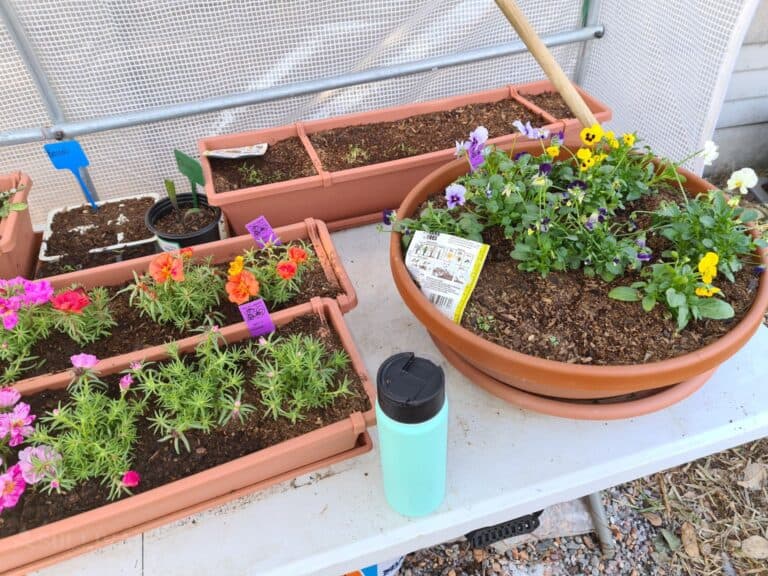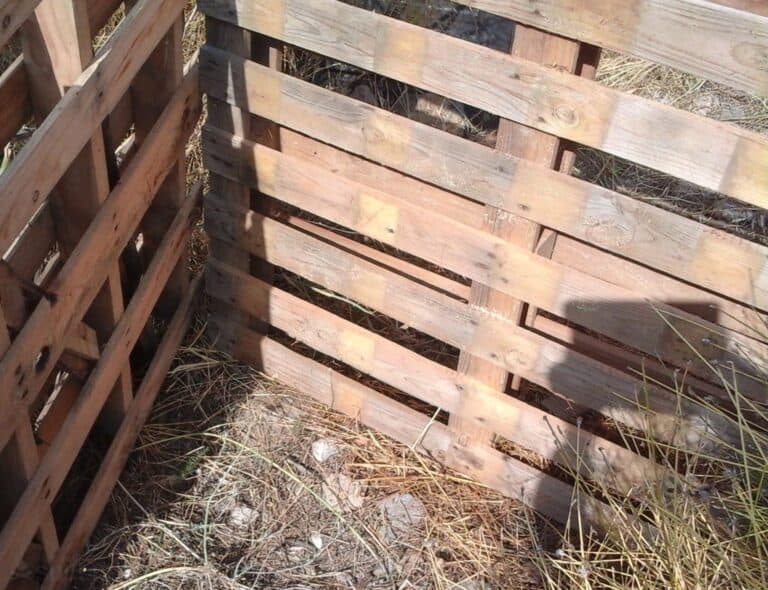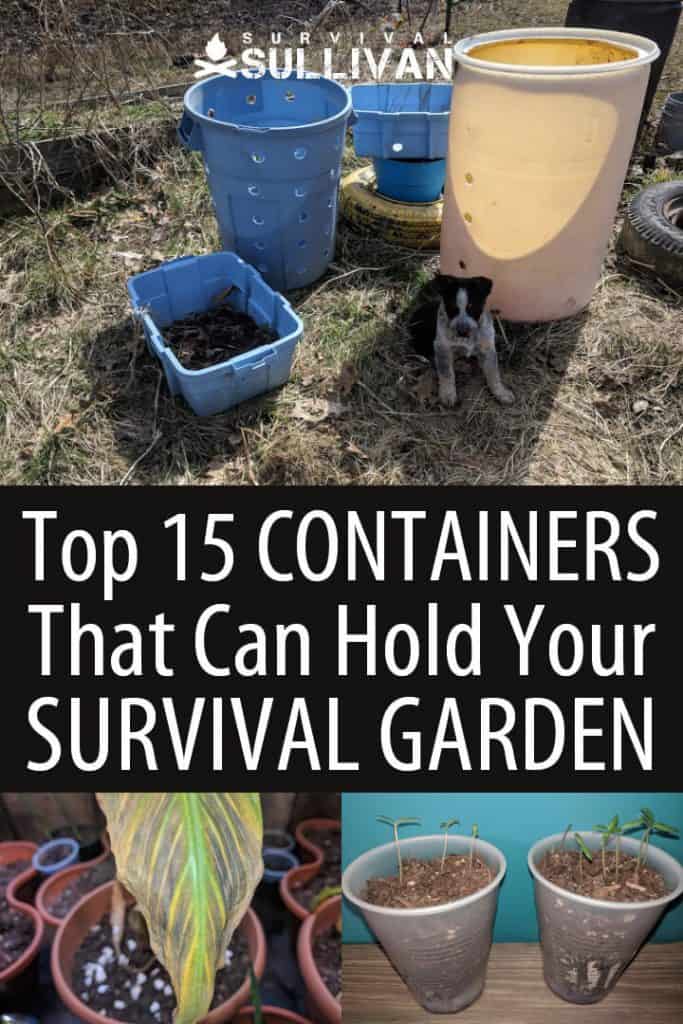Starting a portable survival garden should not require spending a few hundred dollars on containers to grow your own groceries. There is most likely a plethora of suitable survival garden containers already lying around your property, “junk” just waiting to be repurposed into something useful once again.

But first off, what exactly is a garden container?
Any container that can be re-purposed to grow fruits and veggies that you will eat is a garden container. You can get it from a store, or you can reuse buckets, wood pellets, toys and more.
The main benefit is that you can take with you inside the house or in your bug out vehicle should you have to bug out.
Survival garden containers can also be picked up for pennies on the dollar at yard sales, rummage sales, and flea markets. One of the biggest benefits of container gardening for preppers is the ability to make your growing crops portable in case a bugout is suddenly necessary.
To make the most of your growing area, regardless of whether or not you have 50 acres to work with or only ¼ of an acre, use vertical gardening containers in addition to pot style ones. An exterior house wall that gets good sun could be turned into a survival garden area by using purchased, homemade, or upcycled containers.
- Wood Pallets – These sturdy frames make excellent DIY vertical containers for growing crops with roots on the shallow side like lettuce, onions, carrots, etc. Simply staple a landscaping weed mat or thick gauge plastic sheeting to the back of the pallet to prevent dirt from falling out. Poke only tiny holes in the sheeting to allow for proper flow when watering or for when it rains.
- Wheelbarrow – Either a child’s size or standard wheelbarrow that is no longer in good enough shape to haul a load can be quickly repurposed into a survival garden growing container. If the wheelbarrow does not already have any holes or cracks worn into the bottom, use a power drill to make some and simply plant directly into the old gardening tool.
- Plastic Buckets – Old 5-gallon buckets or even smaller buckets (that can be purchased in the cleaning aisle at a Dollar Tree) can also be used to grow crops, herbs, and medicinal flowers.
- Wagon – An old child’s wagon or a gardening wagon that is also no longer in good repair can be used as a highly portable survival garden container. If the wagon does not have any cracks or holes in the bottom, use a power drill to make enough to ensure proper drainage.
- Old Toys – Old metal or plastic trucks that are no longer played with or in decent enough shape to be played with, are excellent for growing many varieties of herbs. The bed of a toy truck, especially if you score a dump truck hiding out in the sandbox or at yard sales, is large and deep enough to use for growing onions and carrots. Drainage holes will need to be drilled into toy truck bed to allow for proper drainage. Plastic toy shopping carts that are lined with landscaping matting or thick plastic can also be used to grow small to medium size garden crops.
- Feed Sacks – Are you saving all those great sturdy feed sacks your horse, cow, goat, or sheep feed come in – or dog food bags? If you have a dozen or so lying around your survival homestead like I do on a regular basis, congratulations – you have ample free garden containers at your disposal. If you cut a flap into the front of the old feed sacks they can be easily used to grow potatoes. You can roll down the tops of a 50-pound bag and use it to plant about any traditional garden crop – even those with tall or wide roots. If you do not need to use the entire bag to accommodate a plant, cut it in half and then fold the bottom of the excess from the top to make a new bottom that can be sewn or duct taped together to create another survival garden growing container.
- Old Boots – Line a pair or a single boot with a layer of plastic, and turn a worn out boot into a gardening container. Drill a couple of holes into the sole of the boot to ensure proper water drainage can take place.
- Plastic Bottles – Turn a plastic water or soda pop bottle sideways, and cut a slice out of the top with a sharp knife. Drill a hole into the top of the bottle’s bottom area, and a corresponding one beneath it, below on the other side. You can now run a string through the holes on one end and around the neck at the top of the bottle to create a hanging vertical survival garden container. A single bottle of water is deep enough to grow onions and many types of herbs. A 2 liter pop bottle is deep enough to grow lettuce and similar lighter weight crops with a short root system.
- Milk Jugs – Plastic milk jugs (and juice jugs) are far too valuable in the garden to be thrown away or even placed in a recycling bin. Cut a hole in the front of the container to plant small crops, and hang or nail the jug up via the handle area to create a vertical growing container. You can also just cut the top part off of the jug and use the base area for a ground level survival growing container. Do not forget to drill some water drainage holes into the bottom of the plastic jug.
- Paint Cans – Thoroughly clean and disinfect used paint containers, drill drainage holes in the bottom, and use them to start seeds or grow entire plants – depending upon the size of the container.
- Tires – You can repurpose old tires into both ground level survival garden growing containers or turn them sideways and mount them to a wall, fence, etc. to create shallow vertical growing pots.
- Logs – Cut a void into a log with a chainsaw or a splitting mull and use it as both a growing container and as a framing border to make a raised bed.
- Cinder Blocks – Turn a cinder block sideways or straight up and down to fill with dirt and use as a growing container.
- Cracked Livestock Waterers – Do not pitch that plastic poultry waterer that cracked in the cold over the winter. Fill it with dirt and use it to grow medium sized crops like broccoli, cabbage, etc. If the waterer has a hanger, you could also use it as a vertical survival gardening container. Simply remove the watering spouts or fountain attachments to open the holes for water drainage.
- 50-Gallon Drums – Cut a 50-gallon plastic or metal barrel in half, and use both parts like you would a tire to grow plants inside. You can also slice open the middle area of the top and the lay drum on its side to use as a growing container. Using a large paddle drill pit you could also make holes all the way around the side of the drum to make holes carrots, onions, lettuce, and the like could grow out of. Do not forget to drill water drainage holes in the bottom of the barrel.
If one of the reasons you are growing a survival garden in containers is to make it portable in case a bugout becomes necessary, there are few things you must take into consideration.
First, dirt is a lot heavier when wet as opposed to dry. Carrying a large container with a mature plant which is nestled in damp soil will likely weigh at least 30 pounds.
Also, when using wheeled containers, like the wagon and wheelbarrow options noted above, moving a mature plant in water soaked dirt over muddy ground will be either extremely difficult or impossible to maneuver without tipping.
Keep some sturdy and thick boards that can be used to create a makeshift road for the wheeled growing container to roll over.
As a prepper, keeping the groceries growing in as covert a manner as possible is probably an essential part of your survival food security plan. To help keep your container garden shielded from prying eyes, choose or paint the containers in colors that blend in with your environment or home.
Mix in herbs, medicinal flowers, and short crops like lettuce, onions, and carrots in with or around traditional landscaping plants to make their presence more demure.

If space allows, do not place all of the survival garden containers in the same area. Scatter them around the backyard area so they blend in with the patio furniture, swingset, etc. At a simple glance, most folks will not notice it is a green bean or tomato plant growing in a pot situated next to a charcoal grill or children’s playhouse.


Tara Dodrill is a homesteading and survival journalist and author. She lives on a small ranch with her family in Appalachia. She has been both a host and frequent guest on preparedness radio shows. In addition to the publication of her first book, ‘Power Grid Down: How to Prepare, Survive, and Thrive after the Lights go Out’, Dodrill also travels to offer prepping tips and hands-on training and survival camps and expos.

I must advise that using multiple size containers makes it 20 times harder to figure how much to water. I made a container garden garden with those black Grow Bags this year and used some pots i already had on hand. I noticed things in the clay pots dried out first, the Grow Bags second, and the plastic pots third. So I had to water the clay pots every day, Grow Bags every other day and plastic pots every 3rd day. And thank goodness they were all in the same small area (30 containers in 3 rows) so i could use one hose and one spray nozzle and not have to walk 2 miles around the yard with a watering can.
Plastic containers will get brittle after a couple of years and crack, break or fall apart. You are better off, in the long run, building raised beds with wood, blocks or any thing else that will last for 10 years +.